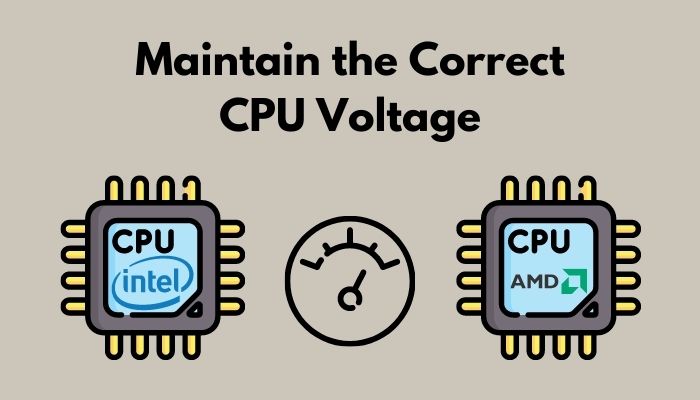You were playing games on your system and suddenly felt that you could overclock the CPU and make it faster. You have searched online and found that by increasing the CPU voltage, you can overclock the CPU. At the same time, you don’t know the safe voltage of a CPU.
I have been a PC enthusiast for a very long time. I have overclocked and used tons of PCs. I believe I can help you with my knowledge and experience.
Stay with me and read the full article to know all the answers you were looking for.
How Much Voltage can a CPU Take?
All processors have a core voltage limit. It usually ranges from 0.9 V to 1.3 V(V stands for volts). This range of CPU voltage is the factory standard for every CPU, even though the CPU has the capability of overclocking. You can increase the voltage limit. However, it is safe to be around 1.35 V to 1.4 V.
Both Intel and AMD have different voltage levels. Intel suggests going up to 1.4 volts, whereas the AMD suggests staying at 1.35 volts. Although, some enthusiasts recommend going up to 1.4 volts.
You can go further, but you may face stability and thermal issues. Your CPU can die if you push excessive voltage. So be careful while increasing the voltage of the CPU.
Why is it Important to Maintain the CPU voltage?
If you want the best possible performance from your system, overclocking is the only way to go. For overclocking a CPU, the core voltage or the VCore is the main part to consider. This VCore is the voltage amount that is delivered to the CPU.
There are three factors that you need to consider before you overclock a CPU. These are energy consumption, heat generation, and stability. All these three things are highly dependent on CPU core voltage.
If you can not maintain the core voltage, the CPU will consume more energy. More energy means more heat generation. Thus the system will not be stable anymore. It will fail to boot up, and you will see constant crashes.
So maintaining the proper voltage is crucial for a CPU. And you need to keep that in mind more than anything else.
How can Voltage Kill the CPU?
A CPU can die due to various reasons. But, high voltage is one of the common reasons for CPUs’ death. At the time of overclocking, users sometimes don’t maintain the safety voltage limit. They go far beyond the safety limit, which results in CPU death.
Also, it’s not ideal if you see the CPU voltage is too low compared to normal range. It can create bottleneck and lower the CPU performance.
Yes, you can eventually go beyond the safety limit if you have an adequate cooling system. Otherwise, it is not wise to push beyond safety limits. When you push extra volts to the CPU, the CPU starts to work faster. At the same time, it becomes really hot. Without a proper cooling solution, this heat can easily fry the CPU.
If you have a decent cooling solution, though overclocking, the CPU eventually reduces the lifespan of the CPU. When you overclock the CPU beyond the safe limit, and at a very high frequency, you can notice the degradation of the CPU at a noticeable rate.
So yeah, this is how the voltage can kill the processor.
How to Maintain the Correct CPU Voltage
If you are using the computer on a default orientation, then you don’t need to worry about the CPU voltage. There is a default CPU voltage for every CPU. The CPU runs at that voltage all the time.
However, if you are a power user like me and love to overclock the CPU, you need to be cautious about maintaining voltage. There is a safe method to overclock both Intel and AMD CPUs by maintaining the correct voltage.
Note: You have to have an excellent cooling solution for the CPU.
Overclocking The Intel CPUs:
You can not overclock any CPU you want. Intel only offers overclocking capabilities to the “K” series processors. All non-K processor doesn’t have overclock capabilities. Like Intel Core i7 11700K supports overclocking, whereas Core i7 11700 does not support overclocking.
Here is the easiest method to overclock the Intel CPU safely:
- Reboot the system and enter inside the BIOS to check the current settings.
- Turn on the computer to do a stress test. And save the result to compare after overclocking.
- Now go back to the BIOS and navigate to the OC, Ai Tweaker, or other overclocking section according to your motherboard.
- Set the CPU multiplier to the desired amount. It is safe to increase the multiplier gradually by 1 stop(100 MHz). For impatient users, use a higher multiplier at a time to check if it works or not.
- Adjust the CPU voltage now. Increase the voltage by a small increment like 0.01 V to 0.05 V. *CAUTION: Do not go beyond 1.4 volts*
- Set the AVX offset to -1 or -2 to reduce the multiplier if the AVX workloads demand more voltage to achieve stability.
- Use different LLC values to check which works for you.
Note: Save changes, reboot the system, and do a stress test to check the performance and stability after every multiplier and voltage increase.
Overclocking AMD CPUs:
Unlike the Intel CPUs, AMD CPUs offer overclocking to all the CPUs. That is why AMD CPUs are more popular than the Intel CPU among tech enthusiasts and gamers. AMD offers auto overclocking. What it does is, let users select the overclocking profile that AMD sets automatically.
Overclocking AMD CPUs are very easy. You can enter BIOS and follow the below steps to overclock your AMD processors.
Here is the easiest method to overclock the AMD CPUs:
- Reboot the system and enter inside the BIOS to check the current settings.
- Turn on the computer to do a stress test. And save the result to compare after overclocking.
- Now go back to the BIOS and navigate to the OC, Ai Tweaker, or other overclocking section based on your motherboard.
- Set the CPU multiplier to the desired amount. It is safe to increase the multiplier gradually by 1 stop(100 MHz). If you know the CPU’s maximum boost clock, you can use that multiplier number to achieve the desired clock speed. (eg. if the CPU can go up to 4.2 GHz from 3.6 GHz, use 100 MHz x 42 to get 4.2 GHz instant.)
- Adjust the CPU voltage according to the stability of the system. Do not go beyond 1.4 V.
- Set the LLC according to the system needs. If the motherboard pushes more voltage, the LLC can lower the tem[perature to stable the stability.
Note: Don’t forget to save changes, reboot the system, and do a CPU stress test to check the performance and stability after every multiplier and voltage increase.
Also, it’s utterly important to monitor the CPU temperature after every changes to see the performance and stability.
FAQs
How many volts does a CPU use?
A CPU typically runs at 0.9 volts to 1.3 volts. But you can always overclock or underclock a CPU. Overclocking gives you better performance while underclocking limits the performance to provide extra stability to the system.
How to check CPU voltage?
You can use any third-party application like CPU-Z. However, you can always check the CPU core voltage inside the BIOS. And I recommend using this method as some third-party applications can often show misinformation.
How much voltage is too much for a CPU?
There is a specific limit for increasing CPU voltage. It is no more than 1.4 volts. Anything more than 1.4 volts can fry the processor. So stay within the limit and enjoy within it.
Final Thoughts
You might already know that there is a limit on voltage increasing, which is safe for the CPU. All the manufacturers and enthusiasts suggest users go as far as 1.4 volts. However, it is safe to stay under 1.4 volts. Stay inside the limit and overclock your CPU. And don’t forget to use an adequate cooling solution. Happy overclocking to you.
Thanks for reading this article. Hopefully, this article gave you all the answers you were looking for. Contact me for any more queries.




